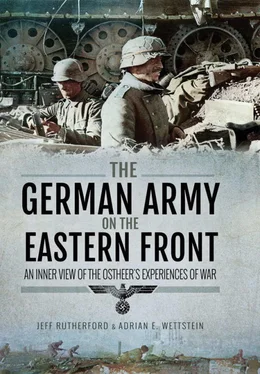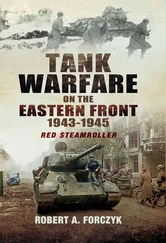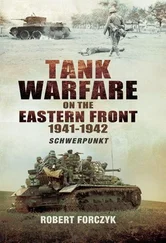As the German attack lost momentum during the late summer due to heavy casualties (especially among officers and NCOs – a topic examined in chapter 2), supply difficulties and the attrition of armour strength, some units found themselves temporarily forced onto the defensive. This was especially true for infantry divisions operating in Army Group Centre during the battle for Smolensk. While German armour divisions were able to ensnare another large number of Soviet formations in a cauldron in this area, Red Army forces from outside of the pocket pounded the thin German cordon. As infantry divisions finally caught up to the exposed panzer divisions and replaced them in the line in hopes of the latter being able to refresh before the next stage of the advance, the war in the centre of the front temporarily shifted to positional warfare. While this was most pronounced during the fighting around the Yel’nya salient from late August through the end of September, Army Group Centre’s panzer divisions had already been forced onto the defensive in early August. Due to the army’s nearly exclusive emphasis on offensive warfare, it was not entirely prepared for fighting on the defensive and, as the following document relates, the commander of the 7th Infantry Division believed that his commanders needed to rethink how they approached this type of warfare. [14]
I reject the type of defence which is frequently carried out.
All depth is missing along the colossal breadth. Therefore, the defence was linear, which as we have learned, is incorrect. I can therefore not agree with the view that one or another commander had, who wouldn’t or couldn’t comply with my thought process and wishes – leading the battle out of strongpoints.
The linear deployment, without reserves behind it, must lead to critical situations, because no one was in the position to influence the battle in anyway. Solely because of this, a locally strong attack on one position had an effect on the breadth [of the line]. [15]
Maintaining the initiative [ das Gesetzt des Handelns ] – active defence – can only be managed out of strongpoints. Actually, everywhere too much was done with men and too little with [the use of] weapons.
With the breadth of the front sections to be secured, our personnel weakness can only be bridged over through a well-considered use of weapons. The conduct of battle must therefore be led from strongpoints that can mutually support each other with flanking fire. The gaps between the individual strongpoints must not only be accepted, but rather they should be accepted since they are the only way to make possible the concentration of strength in an individual sector. Only in this way were the troops in the position to attack an attacking opponent on the flanks even if he had pushed through a gap and then throw them out again through the concentration of men on specific points. This is the only way that command of battle was possible, this is the only way that leaders could intervene and the individual man was not left all alone against the onrushing masses of men.
The 7th Infantry Division moved into the Yel’nya salient on 28 August and began its month-long participation in what, to all intents and purposes, developed into a battle of attrition, a type of combat antithetical to German goals in summer 1941. Developments in the centre of the front caused the first command crisis of the campaign for the army; while the OKH wanted to continue the drive on Moscow, which it believed was the strategic goal, Hitler was determined to seize the economically and ideologically important areas of Leningrad and Ukraine. The stalling of Army Group Centre only reinforced Hitler’s proclivities and he detached the Army Group Centre’s Panzer Groups and diverted them to the flanks. So, while the infantry forces of Army Group Centre fought defensive battles of attrition, its former Panzer Groups fanned out to the north and south. Simultaneous to the fighting in the Yel’nya salient, German forces, including Panzer Group 2, carried out a major encirclement at the battle of Kiev – one which ‘utterly destroyed’ the Soviet South-Western Front, with ‘four Soviet armies and roughly three-quarters of a million men… removed from the Red Army’s order of battle.’ [16]This textbook example of mobile warfare existed in stark contrast to the 7th Infantry Division’s experiences during the Yel’nya battle, as its after-action report on the battle clearly indicated. [17]
On 28 [August] the division was subordinated to the XXth Army Corps and brought forward for an intended deployment in the Yel’nya bend in the vicinity of Cholm. On 30.8., the division was supposed to continue its march in order to relieve a division in its position on the eastern bank of the Yel’nya bend in the night of 31.8. to 1.9. However, this did not take place, because the Russians broke through on 30.8. in the northern section and with tanks further in the south. The planned relief had to be abandoned for the time being.
1 September again brought a change. The Russians attacked the Yel’nya bend on its narrowest position simultaneously from the north and south in order to pinch it off.
Most exposed to these attacks were the left wing of Infantry Regiment 62 near Kukujewa and the adjacent division. Already in the early morning of 1.9., a recognized enemy assembly was smashed by artillery fire. At 8.20 the report arrived that the enemy had broken through in the northern Yel’nya bend. Infantry Regiment 61 was alerted. During the night, an important order was taken off a dead commissar from which could be gathered that an attack by one division was planned for on 1 September. 10:00 1 regiment against Kukujewa, 11:20 1 regiment against Stragina, 11:50 again 1 regiment against Kukujewa. The Russians attacked exactly according to the program and were caught and destroyed by our already waiting artillery. Since the situation in front of the neighbouring division on the left gradually became difficult, the I./Infantry Regiment 61 was subordinated to it and this battalion was deployed in the hot spot near Leonowa. Despite the bloody rebuff that the enemy got in the morning, he again attacked the left wing of Infantry Regiment 62 at Ssoliwenja and Kukujewa at 19:00, but was again repulsed. Since the continuation of the attack had to be expected and the left wing appeared to be threatened due to weak manning of the area, the division brought forward the III./Infantry Regiment 19 to the Barakssina area.
The battle continued. At 13:00 on 2.9., a platoon-strength enemy thrust near Ssolowenjka (in front of Infantry Regiment 62) was repulsed. At 15:00, III./Infantry Regiment 19 began its attack on Kukujewa from a south-westerly direction, found only minimal resistance and pushed into the town. Around 20:00, a Russian counterstroke took place, which forced a temporary clearing of the town. At 3:00, Kukujewa was again occupied by III. and II./Infantry Regiment 19 from the south and west.
On 3.9, the Russians attempted a breakthrough with all means. Day after day, they were attacking in vain. Now it was up to the tanks to create it. At 8:00 7 heavy tanks were reported in the direction of Leonowa, at 8:30 more than 20. Some of them were shot up by artillery, the rest remained stuck in the swamp. The tank attack in the southern part of the Yel’nya bend had failed!
At 10:45, the II./Infantry Regiment 61 was thrown against the enemy who had broken through in the north. Its brave commander, Hauptmann Freiherr von Meyern-Hohenberg, fell at the head of his battalion. At noon on 5.9., he was laid to rest in a dignified ceremony in Chaina in the midst of the then divisional command post.
3.9. had shown that the Russians wanted to spare neither men nor material in order to get a hold of the Yel’nya bend. Since the main point of emphasis for operations lay elsewhere for the time being, higher command decided to withdraw from the Yel’nya bend and to build a new front on the shortest line. [18]The rearward movement began on 5.9. and was for the most part completed on 6.9. The division took over the front of the combat sectors on the Strjana between Arshawez and Charin, with Infantry Regiment 19 and Infantry Regiment 61. Infantry Regiment 62 was withdrawn to the area Panjkowa-Barbarikin-Cholm as a reserve.
Читать дальше






![John Stieber - Against the Odds - Survival on the Russian Front 1944-1945 [2nd Edition]](/books/405234/john-stieber-against-the-odds-survival-on-the-russian-front-1944-1945-2nd-edition-thumb.webp)





